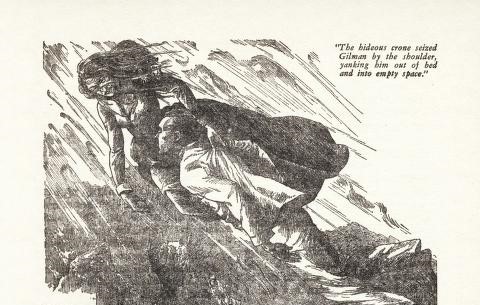The second Lovecraft adaptation in the Guillermo Del Toro’s Cabinet of Curiosities, a horror anthology due to come out on Netflix later this month, has its roots in the world of genuine science. In late
The second Lovecraft adaptation in the Guillermo Del Toro’s Cabinet of Curiosities, a horror anthology due to come out on Netflix later this month, has its roots in the world of genuine science. In late 1931, H.P. Lovecraft attended a lecture by Dutch physicist Willem de Sitter. The topic was The Size of the Universe, and it dealt with the relatively new theories of Einstein, and the concepts of “curved” and “flat” space. The bizarre world of non-Euclidean geometry captured the horror writer’s imagination and expressed itself in one of his more interesting works.
The Dreams in the Witch House is the story of a Miskatonic student named Walter Gilman whose interests lie in a combination of subjects one could only find at that university: mathematics and folklore. He rents an attic room in an old house which once belonged to the witch Keziah Mason. In a trope at least as old as Dracula, the intensely rational young man stumbles upon supernatural mysteries, and is warned away by devout East Europeans who offer him a crucifix. He obviously does not take the warnings to heart and comes to regret the decision.
Many Lovecraft stories find their dramatic center in a sudden, climactic revelation of cosmic horror the protagonist probably should have guessed much earlier on. This story is unusual in being a slow burn, spreading the weirdness and the dark throughout while lacking a single, definitive climax. It also add a twist to the Arthur C. Clarke quip that “Any sufficiently advanced technology is indistinguishable from magic.” Here it is mathematics, not an alternate power source or a strange machine, that allows the master of its arcane art to slip through hidden angles to other points in time and space. The fact that alien worlds are ever present and just around the corner, rather than lost in the depths of time or across limitless black gulfs of infinity, also sets it apart from more popular Lovecraft tales like The Shadow Out of Time or The Call of Cthulhu.
Despite being unusual in several points, The Dreams in the Witch House also refreshes several familiar tropes. The story centers on a house that seems haunted. It is haunted by a witch, and like all good witches, she has a terrifying familiar. His name, “Brown Jenkin,” fits perfectly in classic witch lore, even if his form is more bizarre than in real-world New England stories. The protagonist is also tempted to make a pact with “the Black Man,” whom Cthulhu mythos fans know by another name, and to do so by signing a certain book in blood. Once he does, he can be taken to the throne of the Demon Sultan to make obeisance. A brief moment of heroism is even reminiscent of much later Hammer Horror flicks, though, as always, with a twist.
Strange yet familiar, The Dreams in the Witch House has been adapted several times before. One well-known but poorly reviewed version, originally titled Curse of the Crimson Altar, stars both a late-career Boris Karloff and the inimitable Christopher Lee. Stuart Gordon, who has reanimated Lovecraft for the silver screen more than once, directed a brief and grisly telling for Showtime’s Masters of Horror. These and other adaptations are discussed in an episode of The Good Friends of Jackson Elias, who are always worth visiting for fans of Lovecraft and the broader Cthulhu Mythos. Del Toro’s production, directed by Catherine Hardwicke, is due to come out the twenty-seventh of this month.
I, for one, am excited to see what they do with Brown Jenkin.
